《植物化学保护》课程教学资源(英文讲稿)Work and Residential Characteristics Related to Pesticide Exposure among Latino Farmworkers

Work and Residential Characteristics Related to Pesticide Exposure among Latino Farmworkers Thomas A.Arcury,PhD Department of Family and Community Medicine Wake Forest University School of Medicine Winston-Salem,North Carolina April 2009 Beyond Pesticides:Cutting Edge Pesticide Science Research funded by National Institute of Environmental Health Sciences RO1-ES008739
Work and Residential Characteristics Related to Pesticide Exposure among Latino Farmworkers Thomas A. Arcury, PhD Department of Family and Community Medicine Wake Forest University School of Medicine Winston-Salem, North Carolina April 2009 Beyond Pesticides: Cutting Edge Pesticide Science Research funded by National Institute of Environmental Health Sciences R01-ES008739
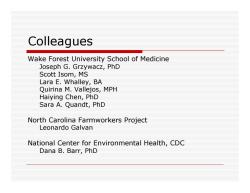
Colleagues Wake Forest University School of Medicine Joseph G.Grzywacz,PhD Scott Isom,MS Lara E.Whalley,BA Quirina M.Vallejos,MPH Haiying Chen,PhD Sara A.Quandt,PhD North Carolina Farmworkers Project Leonardo Galvan National Center for Environmental Health,CDC Dana B.Barr,PhD
Colleagues Wake Forest University School of Medicine Joseph G. Grzywacz, PhD Scott Isom, MS Lara E. Whalley, BA Quirina M. Vallejos, MPH Haiying Chen, PhD Sara A. Quandt, PhD North Carolina Farmworkers Project Leonardo Galvan National Center for Environmental Health, CDC Dana B. Barr, PhD

Background 1 ▣Migrant and seasonal farmworkers experience numerous occupation hazards. Pesticide exposure is a major occupational hazard experienced by farmworkers. Pesticide exposure has been linked to immediate and long-term illnesses
Background 1 Migrant and seasonal farmworkers experience numerous occupation hazards. Pesticide exposure is a major occupational hazard experienced by farmworkers. Pesticide exposure has been linked to immediate and long-term illnesses

Background 2 Organophosphorus (OP) pesticides are the most commonly used insecticides for agriculture. OPs are neurotoxins that are associated with neurobehavioral deficits, cancer,and infertility. ▣Farmworkers are also exposed to other insecticides (e.g., pyrethriods,carbamates), and to herbicides
Background 2 Organophosphorus (OP) pesticides are the most commonly used insecticides for agriculture. OPs are neurotoxins that are associated with neurobehavioral deficits, cancer, and infertility. Farmworkers are also exposed to other insecticides (e.g., pyrethriods, carbamates), and to herbicides
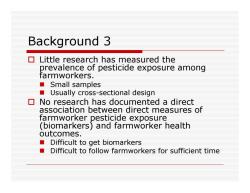
Background 3 Little research has measured the prevalence of pesticide exposure among farmworkers. Small samples Usually cross-sectional design No research has documented a direct association between direct measures of farmworker pesticide exposure (biomarkers)and farmworker health outcomes. Difficult to get biomarkers ■ Difficult to follow farmworkers for sufficient time
Background 3 Little research has measured the prevalence of pesticide exposure among farmworkers. Small samples Usually cross-sectional design No research has documented a direct association between direct measures of farmworker pesticide exposure (biomarkers) and farmworker health outcomes. Difficult to get biomarkers Difficult to follow farmworkers for sufficient time

PACE3 Specific Aims 口Document pesticide exposure levels among farmworkers in North Carolina using urinary biomarkers. Delineate the predictors of pesticide exposure levels among these farmworkers. Develop and implement a plan for disseminating risk information in culturally and educationally appropriate formats
PACE3 Specific Aims Document pesticide exposure levels among farmworkers in North Carolina using urinary biomarkers. Delineate the predictors of pesticide exposure levels among these farmworkers. Develop and implement a plan for disseminating risk information in culturally and educationally appropriate formats
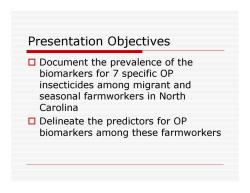
Presentation Objectives Document the prevalence of the biomarkers for 7 specific OP insecticides among migrant and seasonal farmworkers in North Carolina Delineate the predictors for OP biomarkers among these farmworkers
Presentation Objectives Document the prevalence of the biomarkers for 7 specific OP insecticides among migrant and seasonal farmworkers in North Carolina Delineate the predictors for OP biomarkers among these farmworkers
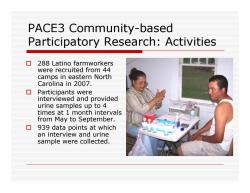
PACE3 Community-based Participatory Research:Activities 288 Latino farmworkers were recruited from 44 camps in eastern North Carolina in 2007. ▣Participants were interviewed and provided urine samples up to 4 times at 1 month intervals from May to September. 939 data points at which an interview and urine sample were collected
PACE3 Community-based Participatory Research: Activities 288 Latino farmworkers were recruited from 44 camps in eastern North Carolina in 2007. Participants were interviewed and provided urine samples up to 4 times at 1 month intervals from May to September. 939 data points at which an interview and urine sample were collected
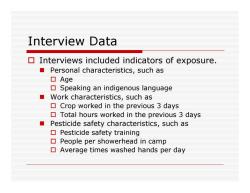
Interview Data Interviews included indicators of exposure Personal characteristics,such as ▣Age Speaking an indigenous language Work characteristics,such as Crop worked in the previous 3 days Total hours worked in the previous 3 days Pesticide safety characteristics,such as Pesticide safety training People per showerhead in camp Average times washed hands per day
Interview Data Interviews included indicators of exposure. Personal characteristics, such as Age Speaking an indigenous language Work characteristics, such as Crop worked in the previous 3 days Total hours worked in the previous 3 days Pesticide safety characteristics, such as Pesticide safety training People per showerhead in camp Average times washed hands per day

Urinary Metabolite Data Urine samples were analyzed for 7 OP pesticide urinary metabolites: TCPy (chlorpyrifos; chlorpyrifos methyl) ■CMHC(coumaphos) ■IMPY(diazinon) ■CIT(isazaphos) ■MDA(malathion) PNP(parathion;methyl parathion) DEAMPY (primiphos methyl)
Urinary Metabolite Data Urine samples were analyzed for 7 OP pesticide urinary metabolites: TCPy (chlorpyrifos; chlorpyrifos methyl) CMHC (coumaphos) IMPY (diazinon) CIT (isazaphos) MDA (malathion) PNP (parathion; methyl parathion) DEAMPY (primiphos methyl)
按次数下载不扣除下载券;
注册用户24小时内重复下载只扣除一次;
顺序:VIP每日次数-->可用次数-->下载券;
- 《植物化学保护》课程教学资源(英文讲稿)TOXICOLOGY III Risk Assessment(PPT).ppt
- 《植物化学保护》课程教学资源(英文讲稿)Toxic Effects of Pesticides.pdf
- 《植物化学保护》课程教学资源(英文讲稿)The Influence of Secondary Standards on Pesticide Use.pdf
- 《植物化学保护》课程教学资源(英文讲稿)The Impacts of Adoption of Genetically Engineered Crops on Yields, Pesticide Use and Economic Returns in the USA.pdf
- 《植物化学保护》课程教学资源(英文讲稿)Storage and Disposal.pdf
- 《植物化学保护》课程教学资源(英文讲稿)Plastic Pesticide Container Recycling.pdf
- 《植物化学保护》课程教学资源(英文讲稿)Pesticides.pdf
- 《植物化学保护》课程教学资源(英文讲稿)Pesticides Analysis with the new Agilent 6220 6460 and 6530.pdf
- 《植物化学保护》课程教学资源(英文讲稿)Pesticide Waste Challenges.pdf
- 《植物化学保护》课程教学资源(英文讲稿)Pesticide Toxicology and Risk Assessment.pdf
- 《植物化学保护》课程教学资源(英文讲稿)Pesticide Toxicity.pdf
- 《植物化学保护》课程教学资源(英文讲稿)Pesticide Safety and Toxicity(PPT).ppt
- 《植物化学保护》课程教学资源(英文讲稿)Pesticide Registration for Minor Crops and Crop Grouping Effort in Japan.pdf
- 《植物化学保护》课程教学资源(英文讲稿)Pesticide Laws and Regulations.pdf
- 《植物化学保护》课程教学资源(英文讲稿)Pesticide Health Hazards - Exposure and Personal Protective Equipment.pdf
- 《植物化学保护》课程教学资源(英文讲稿)Pesticide Hazards and First Aid(PPT).ppt
- 《植物化学保护》课程教学资源(英文讲稿)Pesticide Formulas and Properties.pdf
- 《植物化学保护》课程教学资源(英文讲稿)Pesticide Contamination in Rural Areas.pdf
- 《植物化学保护》课程教学资源(英文讲稿)Pesticide Toxicology(PPT).ppt
- 《植物化学保护》课程教学资源(英文讲稿)Oklahoma Unwanted Pesticide Disposal Program.pdf
- 华南农业大学:《普通昆虫学》课程教学大纲(负责人:王敏).pdf
- 华南农业大学:《普通昆虫学》课程授课教案(讲义,共五篇).docx
- 华南农业大学:《普通昆虫学》课程教学资源(实验指导)实验一 昆虫体躯的基本结构和昆虫的头部.pdf
- 华南农业大学:《普通昆虫学》课程教学资源(实验指导)实验二 昆虫的胸部和腹部.pdf
- 华南农业大学:《普通昆虫学》课程教学资源(实验指导)实验三 昆虫的卵、胚胎发育和胚后发育.pdf
- 华南农业大学:《普通昆虫学》课程教学资源(实验指导)实验四 昆虫纲分目(Ⅰ).pdf
- 华南农业大学:《普通昆虫学》课程教学资源(实验指导)实验五 昆虫纲分目(Ⅱ).pdf
- 华南农业大学:《普通昆虫学》课程教学资源(实验指导)实验六 等翅目、直翅目和缨翅目分科.pdf
- 华南农业大学:《普通昆虫学》课程教学资源(实验指导)实验七 半翅目和脉翅目分科.pdf
- 华南农业大学:《普通昆虫学》课程教学资源(实验指导)实验八 同翅目分科.pdf
- 华南农业大学:《普通昆虫学》课程教学资源(实验指导)实验九 鞘翅目分科.pdf
- 华南农业大学:《普通昆虫学》课程教学资源(实验指导)实验十 鳞翅目分科(成虫).pdf
- 华南农业大学:《普通昆虫学》课程教学资源(实验指导)实验十一 鳞翅目分科(幼虫).pdf
- 华南农业大学:《普通昆虫学》课程教学资源(实验指导)实验十二 双翅目科.pdf
- 华南农业大学:《普通昆虫学》课程教学资源(实验指导)实验十三 膜翅目分科.pdf
- 华南农业大学:《普通昆虫学》课程教学资源(实验指导)实验十四 昆虫内部器官的位置、体壁、消化系统.pdf
- 华南农业大学:《普通昆虫学》课程教学资源(实验指导)实验十五 昆虫的呼吸系统、循环系统、神经系统、内分泌系统和生殖系统.pdf
- 华南农业大学:《普通昆虫学》课程教学资源(实验指导)实习一 昆虫标本的采集、制作与保存.pdf
- 华南农业大学:《普通昆虫学》课程教学资源(实验指导)实习二 微小昆虫玻片标本的制作.pdf
- 华南农业大学:《普通昆虫学》课程教学资源(实验指导)实习三 昆虫的科学绘图.pdf
